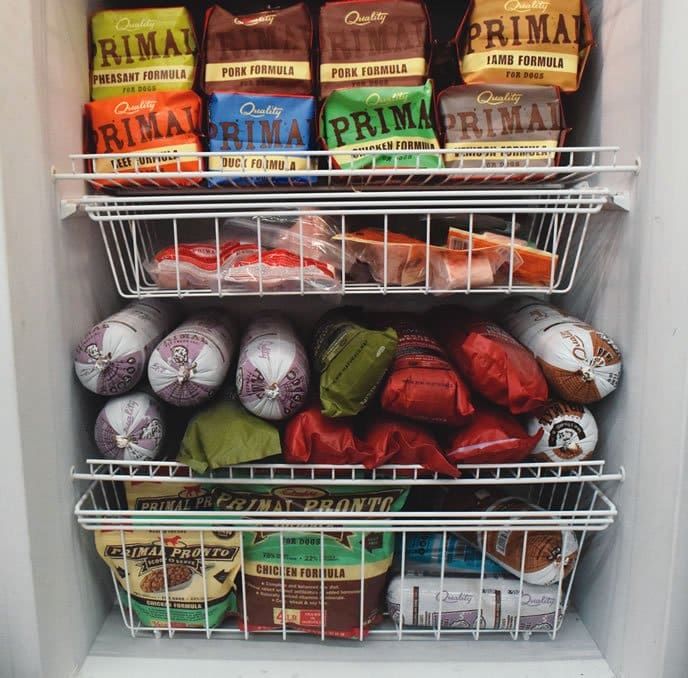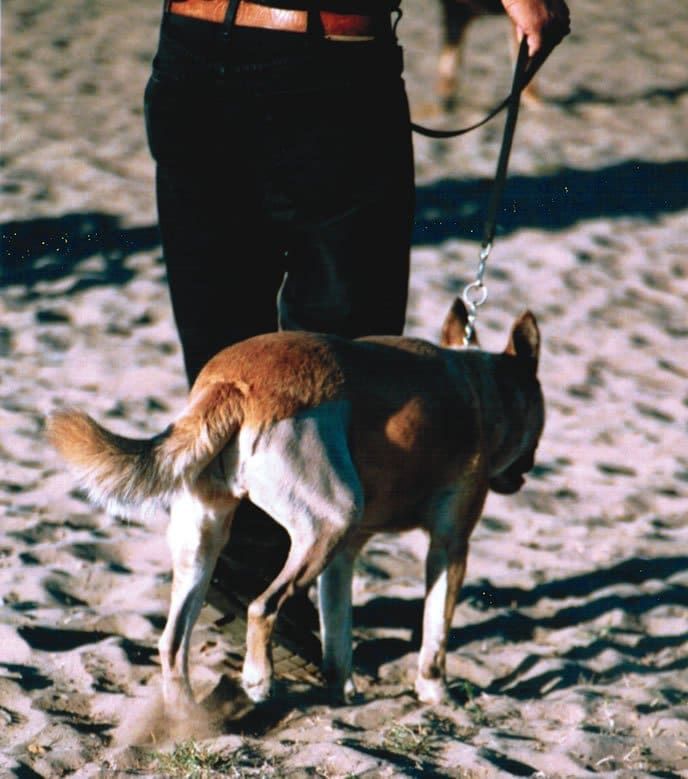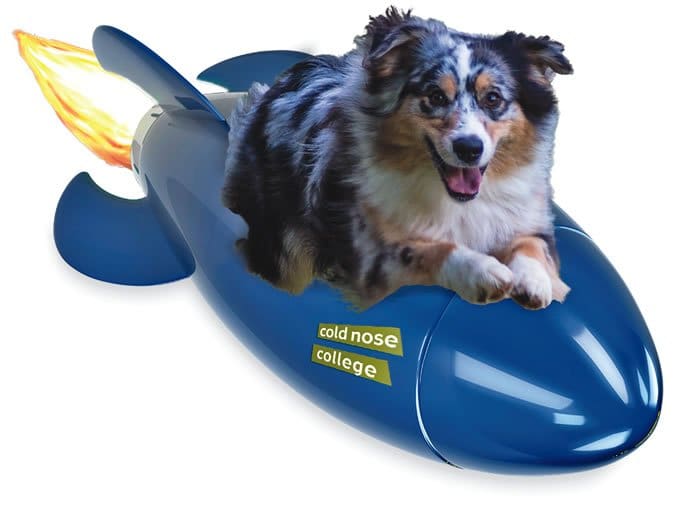
The State of the Commercial Raw Diet Industry
Three of the most knowledgeable and experienced advocates of well-formulated raw diets for dogs have joined forces to explain how to evaluate commercial raw diets. We described them in the inaugural installment of this column last month: Dr. Karen Becker, a leading holistic veterinarian; Steve Brown, one of the founders of this industry; and Mary Straus, one of the most dedicated canine nutrition researchers and writers. This month, we’ve asked them to address the state of the commercial raw diet industry, starting with diets that are labeled as “complete and balanced” or “AAFCO-compliant” (formulated to meet the nutritional levels established by the Association of American Feed Control Officials).
Their executive summary? More and more dog owners and veterinarians are learning that well-formulated raw diets are the best food for most dogs most of the time – but the commercial raw dog food industry has problems. They are disappointed with the apparent lack of basic nutritional knowledge demonstrated by many companies – as evidenced by the formulation of their products – despite the manufacturers’ good intentions.
They hasten to add, however, that consumers can learn how to evaluate raw products and the companies that make them, in order to avoid the poorly formulated ones and buy the best products for their dogs. While consumers have no way to determine the quality of the ingredients used by the manufacturers, or whether they really include the ingredients listed on their product labels, owners can evaluate the companies’ formulation proficiency and how that impacts the nutritional adequacy of their products.
Following are six guidelines to help you evaluate commercial raw diets. – Nancy Kerns, Editor.
1. For puppies, make sure the food contains both calcium and phosphorus sources.
This is number one on Dr. Becker’s list of things that are most important for good health. Bone meal, dicalcium phosphate, tricalcium phosphate, or calcium hydroxyapatite must be added to boneless foods in order to meet American (AAFCO1), European (FEDIAF2), or ancestral growth guidelines for phosphorus. For adult maintenance, a calcium-only source is usually acceptable.
Puppies need more calcium and phosphorus than adult dogs do to support their growing bones. Both the total amounts of and the ratio between calcium and phosphorus are important in order to prevent growth abnormalities in large-breed puppies. Manufacturers must know how to provide proper calcium and phosphorus amounts and ratios for puppies if they claim their food meets AAFCO guidelines for growth or all life stages, yet many companies seem not to understand this critical point.
According to hundreds of simulations and tests that Steve has run with Mary’s confirmation, in order to meet AAFCO guidelines for growth, both calcium and phosphorus must be added to diets that do not contain bone (bone provides both calcium and phosphorus). Meat contains a fair amount of phosphorus, but even an all-meat diet does not provide sufficient phosphorus for growth stages.
Calcium-only supplements such as calcium carbonate, eggshell powder, coral calcium, and oyster shell powder will not suffice, as they do not provide the additional phosphorus required for proper growth.
In Table I, we list the amounts of calcium and phosphorus that are required by AAFCO for canine adult (“maintenance”) and puppy (“growth”) diets – and show how adding a calcium-only supplement to a bone-free recipe comprised of 80 percent low-fat meat and 20 percent vegetables – or even a recipe with all meat! – would fall short of meeting calcium and phosphorus standards for puppies. If you add enough calcium to meet the minimum required for growth, the ratio of calcium to phosphorus will exceed the maximum allowed, which can be particularly harmful to large-breed puppies.
TABLE I: Boneless Puppy Diets Need Added Phosphorus
| Guidelines (grams per 1,000 calories) | Calcium (Ca) | Phosphorus (P) | Ca : P Ratio |
|---|---|---|---|
| AAFCO 2014* adult maintenance requirement (minimum) | 1.25 | 1 | 1:1 to 2:1 |
| AAFCO 2014* growth and reproduction requirement (min) | 3 | 2.5 | 1:1 to 2:1 |
| Sample recipe with 80% meat, 20% veg, no added calcium | 0.1 | 1.1 | 0.1:1 |
| Same recipe with adequate calcium for growth added | 3 | 1.1 | 2.7:1 |
| All-meat recipe, same amount of calcium | 3.1 | 1.1 | 2.8:1 |
2. Look for foods that are formulated on a caloric basis, not dry matter.
We’re not going to sugar-coat this one: To determine whether or not a food has been properly formulated on a caloric basis is going to require some diligence on your part; it’s not something that will be easily found on a product label. You will have to contact the commercial raw food manufacturer and ask for a nutritional analysis of their product based on calories. In our opinion, if a manufacturer cannot provide you with this analysis or fails to respond to your request, they shouldn’t be trusted to provide your dog with complete and balanced nutrition.
The AAFCO Official Publication and the European equivalent, the FEDIAF Nutritional Guidelines, both list nutrient profiles in two different ways: by weight (dry matter, or DM) and by calories (kcal of metabolizable energy, or ME). For typical high-carbohydrate, lower-fat dry dog foods with low or moderate calories, a manufacturer can use DM profiles. For high-calorie foods, however, including essentially all commercial raw diets, manufacturers must use the profiles based on calorie content, or correct for energy density.
Raw diets are energy dense because even the leanest raw diets have a lot of fat compared to kibble. Fat has more than twice the calories per gram as protein and carbs do, so the more fat in a diet, the more calories. You therefore feed less (by weight) of higher-fat diets to provide the same number of calories, meaning your dog will get less of all the other nutrients in the diet unless those nutrients have been increased (corrected for energy density).
If a raw dog food company formulates on a dry matter basis (amounts per kilogram DM), rather than a caloric basis (amounts per 1,000 kcal), without correcting for energy density, the food will probably not meet AAFCO’s nutritional standards for complete and balanced pet food. Most of the raw diet companies willing to provide a nutritional analysis report on a DM basis, and their diets appear to be formulated to meet the AAFCO DM guidelines, without correcting for energy density.
To illustrate the sometimes big differences between using dry matter and caloric guidelines, we created a basic recipe, consisting of only meat (85 percent lean ground beef) with enough supplements added to balance the recipe on a dry matter basis. The recipe meets all AAFCO 2014* mineral recommendations for all life stages on a dry matter basis (see Table II). But on a caloric basis, this recipe falls well short of AAFCO minimums for every mineral, and provides only about two-thirds of the minimum recommended amount of calcium and phosphorus for growing puppies.
TABLE II: AAFCO 2014* All Life Stages
| Dry Matter Basis | Caloric Basis | |||||
|---|---|---|---|---|---|---|
| Nutrient | Units, DM basis | AAFCO 2014* DM required minimums | "Basic Recipe", DM | Units per 1,000 kcal | AAFCO 2014* required min. per 1,000 kcal | "Basis Recipe", per 1,000 kcal |
| Calcium (Ca) | % | 1.2% | 1.2% | g | 3.0 | 2.1 |
| Phosphorus (P) | % | 1.0% | 1.0% | g | 2.5 | 1.7 |
| Potassium (K) | % | 0.6% | 0.8% | g | 1.5 | 1.4 |
| Sodium (Na) | % | 0.3% | 0.3% | g | 0.8 | 0.6 |
| Magnesium (Mg) | % | 0.06% | 0.06% | g | 0.15 | 0.11 |
| Iron (Fe) | mg/kg | 88 | 91 | mg | 22 | 16 |
| Copper (Cu) | mg/kg | 124 | 129 | mg | 3.1 | 2.2 |
| Manganese (Mn) | mg/kg | 7.2 | 7.6 | mg | 1.8 | 1.3 |
| Zinc (Zn) | mg/kg | 100 | 124 | mg | 25 | 21 |
| Iodine (I) | mg/kg | 1 | 1.15 | mg | 0.25 | 0.2 |
| Selenium (Se) | mg/kg | 0.35 | 0.44 | mg | 0.09 | 0.08 |
3. Watch out for too much fat.
If a fresh (not freeze-dried or dehydrated) raw food that contains vegetables has more than 60 kcal/oz (960 kcal/lb or 2,116 kcal/kg), or a food without vegetables has more than 65 kcal/oz (1,040 kcal/lb or 2,293 kcal/kg), the fat content may exceed safe upper limits. If it’s a beef food, it may be short on tryptophan, and if poultry, it may have too much linoleic acid (LA), an omega-6 fatty acid that is considered to be pro-inflammatory at high levels. The food should be avoided.
Raw diets can be expensive to produce, so there’s an incentive for manufacturers to use less expensive high-fat meats, resulting in products that may not be a healthy choice for many dogs. Ideally, canine diets should have about twice as much protein as fat. We do not recommend ever feeding foods with more fat than protein.
Higher-fat foods have a greater likelihood of failing to meet every nutritional standard for a complete and balanced diet. Basing a diet on fatty meats can result in products that fall short of minimum recommended amounts of protein for puppies, exceed safe upper limits for total fat, and have poorly balanced fats. High-fat poultry diets may exceed AAFCO and FEDIAF maximums for LA.
Equally concerning are beef diets formulated on a base of 70 percent lean beef; such a diet fails to provide even half of the minimum recommendations for the essential amino acid tryptophan (some studies suggest that diets with inadequate tryptophan may lead to aggressive behaviors and contribute to anxiety disorders).
It’s difficult to know the real fat content of a food because fat is listed on the label as a guaranteed minimum amount, not the actual amount, which may be considerably higher. We’ve seen foods listing 8 percent fat on the label that, when tested, actually contained 18 percent fat. The best way to determine the fat content of a food is to check the number of calories in the food; high calories = high fat. This information is often on the website; if not, call the company to ask.
Nutrient standards aside, we’re concerned about people feeding their dogs diets with the consistently high fat content seen across the board in commercial raw products. For comparison, fresh raw foods with 60 to 65 calories per ounce would normally have about 50 percent fat on a dry matter basis (look at the freeze-dried versions to get a better idea of how much fat these products contain when moisture is removed). Compare that to kibble, where 20 percent fat is considered to be a high-fat diet; these foods contain more than twice as much fat!
Another way to look at the amount of fat in the diet is as a percentage of calories. Sled dogs, who work hard in cold temperatures and need more fat than just about any other dogs, are commonly fed diets where about 60 percent of calories come from fat. In comparison, raw diets with 60 to 65 calories per ounce typically derive more than 70 percent of their calories from fat!
Too much fat can lead to digestive upset and even pancreatitis in susceptible dogs, especially those switched suddenly from a diet much lower in fat. Feeding high-fat diets can also lead to obesity, or to nutritional deficiencies. The latter can occur if the dog is fed less in order to prevent weight gain, unless the manufacturer compensated for the high fat level (increased calories) by adding more nutrients. In other words, your dog still needs the same amount of vitamins and minerals each day, even if you have to reduce how much he is fed in order to provide an appropriate number of calories. Nutritional deficiencies are more likely to affect dogs who eat less than would be expected for their weight (including older and less active dogs).
4. Beware of foods containing beef liver and copper supplements.
In every recipe we’ve analyzed, there is no need to add a copper supplement to a recipe with beef liver, which is rich in copper (see Table III). In many cases, adding a copper supplement to a recipe that includes beef liver causes the diet to exceed the European legal limit for copper in dog food.
Why do companies add copper to diets containing beef liver? Because it’s easier and less expensive for a manufacturer to use just one supplement mix than to have various mixes for different products. They buy in greater volumes and therefore get lower costs. But in our opinion, there is no good reason for the larger raw diet manufacturers to use the same supplement mix for all of their products.
This is especially important for certain breeds of dogs that may have a genetic propensity toward copper toxicosis (CT) even when fed commercial dog food that meets AAFCO guidelines. CT is a particularly severe problem in Bedlington Terriers, but it has been recognized in up to 53 other breeds, including Dalmatians, Doberman Pinschers, Labrador Retrievers, Skye Terriers, and West Highland White Terriers, where pedigree studies have confirmed a hereditary cause. Recent findings indicate that other breeds may also be affected, including the Airedale Terrier, American Cocker Spaniel, Anatolian Shepherd, Beagle, Boxer, Cavalier King Charles Spaniel, German Shepherd, Keeshond, and Norfolk Terrier, as well as mixed-breed dogs. We’ll write more about this in a future issue.
In a seminar that Dr. Becker and Steve Brown conduct, they build two similar recipes, with one based on boneless beef and the other on bone-in poultry. See Table IV to compare the amounts of copper in each recipe before supplementation. They make the point that if they added the same amount of copper to both recipes to enable the chicken recipe to reach AAFCO minimum amounts for growth, they’d be very close to exceeding European legal limits for copper in the beef recipe.
Indeed, in our preparation work for this article, we found many beef diets that exceed FEDIAF legal limits for copper. As an example, one leading raw diet company produces several varieties of “complete and balanced” foods for “all life stages” using the same premix, with copper supplements, in all the foods. According to its own analyses, its chicken variety has either 2.6 or 5.4 mg copper per 1,000 calories (values provided vary between the frozen and freeze-dried versions, which should be identical), which may meet AAFCO minimum recommendations for growth, while its beef variety has about 29 mg copper per 1,000 calories, more than four times the European legal limit of 7.1 mg (again, see Table IV).
Looking at it another way, its chicken food has either 12 or 27 mg/kg DM of copper, meeting minimum recommended amounts of 9 mg/kg for adult dogs (after correcting for the calories in this food) and possibly meeting minimum recommended amounts for puppies of 15 mg/kg (after correction), while its beef food has about 160 mg/kg of copper, more than four times the European legal limit of 39 mg/kg DM (after correction).
TABLE III: Copper Amounts in Liver
| Type of liver | Copper mg/kg (as fed) |
|---|---|
| Chicken liver, raw | 5 |
| Turkey liver, raw | 9 |
| Beef liver, raw | 98 |
| Lamb liver, raw | 70 |
TABLE IV: Copper in Sample Chicken and Beef Recipes Before Supplementation
| AAFCO 2014* | FEDIAF | RECIPES | |||
|---|---|---|---|---|---|
| Adult (min) | Growth (min) | Legal limit (max) | Chicken | Beef | |
| Copper, mg/1,000 kcal | 1.8 | 3.1 | 7.1 | 1.1 | 4.5 |
| Copper, mg/kg DM | 7.3 | 12.4 | 28 | 5.5 | 25.2 |
5. Check the ingredients list for sources of manganese, iodine, and vitamin E.
Through years of analyses, the development of hundreds of recipes, and many more hundreds of simulations, Steve has found that it is very difficult to meet AAFCO’s minimum guidelines for iodine, manganese, and vitamin E without using supplements or including very specific foods. If one does not see specific foods or supplements for iodine, manganese, and vitamin E, the foods likely will not meet the definition of complete and balanced, and may not be healthy. Note that while some manufacturers claim that spirulina is a source of manganese and/or iodine in their foods, it’s not likely to provide enough to meet the recommended amounts.
Manganese
Manganese deficiency primarily affects puppies. Symptoms can include poor growth and skeletal abnormalities (shortening and bowing of the forelegs). In adults, it has been linked to lameness, enlarged joints, and ataxia (loss of balance). Manganese deficiency has also been reported to have profound negative effects on reproduction, and may contribute to cruciate ligament injuries.
Usually, raw food manufacturers need to add a manganese supplement in order to meet minimum manganese standards, unless they contain specific food sources of manganese. Organ meats (such as liver and kidney, but not heart) are rich in manganese, but to reach the required level of manganese with only these foods, you’d have to include so much that the diet would exceed maximums for vitamin A, and perhaps copper and other nutrients. The ancestral diet of dogs provided ample manganese from the small organs and glands found in whole prey, but these are impractical for manufacturers to source.
Look for a manganese source. Mussels and some species of clams are rich in manganese, but also expensive. Some spices, such as clove and ginger, are high in manganese, but large amounts would be needed to meet manganese standards, and the food may not be palatable. Whole grains are also high in manganese, as are leafy green and some other vegetables, berries, and legumes (beans). Adding 10 percent whole grains and 20 percent manganese-rich vegetables will enable a food to meet minimum requirements.
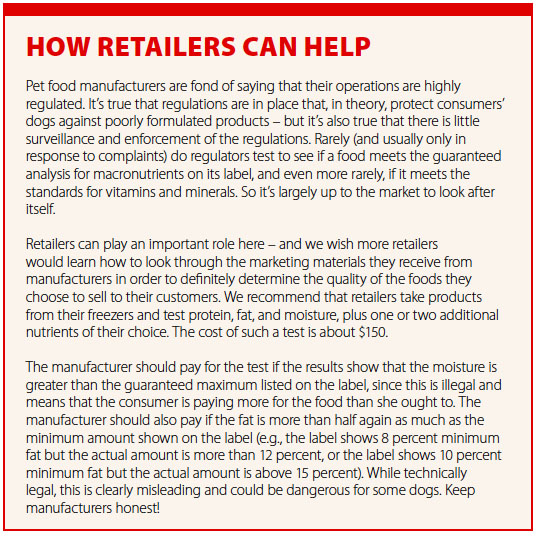
Iodine
Iodine is required by the body for many physiological processes, including healthy thyroid function. Consistently low intake of iodine can contribute to hypothyroidism and goiter (enlarged thyroid gland) in all breeds of dogs. Long-term deficiency can cause myxedema, which affects the skin, and skeletal deformities. Other signs of deficiency may include hair loss, lethargy, and fearfulness.
Look for specific sources of iodine. Some kelp products, but not all, are iodine-rich; the manufacturer needs to use specific brands to ensure proper amounts of iodine. Some manufacturers provide iodine with iodized salt, or a supplement such as Ethylenediamine Dihydriodide (EDDI).
Vitamin E
Vitamin E is an antioxidant that helps to protect the fats in your food and in your body from oxidizing (going rancid, creating free radicals that cause cell damage). Vitamin E is essential in keeping the cells of the muscles, heart, liver, and nerves alive and functioning. Long-term deficiency can lead to “brown bowel syndrome,” causing ulceration, bleeding, and degeneration of the intestines. The eyes can also be affected.
Look for specific sources of vitamin E (tocopherols) in the foods you feed. Unless the company uses a lot of of wheat germ oil, a vitamin E supplement should be included. The polyunsaturated fats in poultry and fish require more vitamin E protection than do the saturated fats in beef and bison foods.
6. If a company uses linear feeding directions, question the company’s competency.
If a company recommends that a 40-pound dog be fed twice as much as a 20-pound dog, or states “feed 2-3 percent of the dog’s body weight per day,” the company hasn’t studied basic nutrition or paid attention to the feeding directions done by professionals. Their foods may still be good, but it’s not a good sign that they don’t understand the basic energy requirements of dogs.
There are many different formulas for calculating energy needs, but they all rely on one simple fact: large dogs need fewer calories per pound of body weight than do small dogs. An active 10-pound dog on a lean diet may require 8 percent of her body weight or more per day, while a moderately active 110-pound dog eating a fattier diet may require less than one percent of her body weight per day.
Feeding directions are meant to be a starting point for determining each individual dog’s needs; people should feed whatever amount is needed to keep their dogs at a proper weight. But the use of linear feeding directions (e.g., showing double the amount of food for double the amount of weight) shows that the manufacturer has not done its homework – and is passing along an over-casual recommendation to its consumers.
In our survey, we found that fewer than one-third of raw food companies use appropriate, non-linear feeding directions, while 100 percent of the companies that make dry food use proper feeding directions.
Conclusions
The commercial raw pet food industry is growing rapidly, providing dozens of brands to choose from, ranging from excellent to poor quality. Through our research we have found well-intentioned companies that want to formulate correctly, but it appears they just don’t know how. We have also found companies whose principals know their products don’t meet these important guidelines and don’t seem to care. It’s up to owners to check and confirm that the makers of their dogs’ food are doing things right. These guidelines will help you make the best decisions about what commercial raw foods to feed – or may expedite a transition onto a homemade diet. Future articles in this series will show you how!
In the meantime, there are some great raw diets on the market. If you follow these guidelines, you’ll be able to find them. (We are hesitant to name companies in this series because Dr. Becker and Steve provide consultation services for several of them, and we want to avoid conflicts of interest.)
Feed a variety of different brands using different protein sources to help make up for what may be missing or excessive in any individual product. Nutritional deficiencies and imbalances don’t make a food dangerous per se, particularly if it’s used as only part of a varied diet. The danger is much greater for dogs fed only one brand or type of food continuously.
If you must feed one brand exclusively, or if you’re feeding a growing puppy or pregnant or nursing female, choose a company that is willing and able to provide you with a full nutritional analysis done on a caloric basis, ideally compared to the AAFCO standards.
Consumers can play an important role in making the commercial raw diet industry better. All you need do is question the manufacturers and ask to see their nutritional analyses. When you buy commercial raw diets, you are spending a lot of money and deserve and have the right to ask detailed questions. The more you question, the better the products will become and the better dogs will be fed.
We hope companies will use these guidelines to make improvements and corrections with their products, if needed. The fact that only about a third of the raw food companies have correct feeding instructions should be concerning to everyone. Put pressure on the companies to do it right, and you’ll help your dogs and many others.
How Retailers Can Help
Pet food manufacturers are fond of saying that their operations are highly regulated. It’s true that regulations are in place that, in theory, protect consumers’ dogs against poorly formulated products – but it’s also true that there is little surveillance and enforcement of the regulations. Rarely (and usually only in response to complaints) do regulators test to see if a food meets the guaranteed analysis for macronutrients on its label, and even more rarely, if it meets the standards for vitamins and minerals. So it’s largely up to the market to look after itself.
Retailers can play an important role here – and we wish more retailers would learn how to look through the marketing materials they receive from manufacturers in order to definitely determine the quality of the foods they choose to sell to their customers. We recommend that retailers take products from their freezers and test protein, fat, and moisture, plus one or two additional nutrients of their choice. The cost of such a test is about $150.
The manufacturer should pay for the test if the results show that the moisture is greater than the guaranteed maximum listed on the label, since this is illegal and means that the consumer is paying more for the food than she ought to. The manufacturer should also pay if the fat is more than half again as much as the minimum amount shown on the label (e.g., the label shows 8 percent minimum fat but the actual amount is more than 12 percent, or the label shows 10 percent minimum fat but the actual amount is above 15 percent). While technically legal, this is clearly misleading and could be dangerous for some dogs. Keep manufacturers honest!
Filing an Appeal
Insurance companies are in the business to make money, and anything they can legally deny, they will. However, that doesn’t mean they’re always right. You can file a letter of appeal with your insurer, but you need more than a stern letter. You need proof that you’re right. The evidence you need depends upon the disagreement and your contract.
If they’re denying payment for a treatment because they considered it not medically necessary, or experimental/investigative, consider sending them proof to the contrary, such as statements from other veterinarians and veterinary groups that support your case, research papers that support the treatment, and even case histories of dogs with similar illnesses who recovered successfully with the treatment you chose for your dog.
If the plan you have chosen has a “benefit schedule,” it will be very difficult to win an appeal because you have already in essence agreed to accept specific, set reimbursements for any care needed by your dog. If you have a U&C contract, you’ll need to include tangible proof that the amount charged by your veterinary is “reasonable.” Consider sending them Internet searches that show similar charges, examples of other cases and fees similar to your bill, and cost-of-living comparisons, if you suspect the U&C didn’t take your geographic location into consideration.
Be prepared to fight. Rarely do you win on first appeal; instead, you will likely receive an initial rejection, repeating your contract provisions. If your case has merit, most insurers will give in with your second letter. However, you may have to appeal to your state’s insurance commissioner. Some states require a small fee (about $50) before they will examine your appeal, but it may be money well spent, as most companies want to avoid being frequently scrutinized by the state and they may give in to your request almost immediately upon receiving news of your appeal at this level.
Teach Your Dog To Settle Down
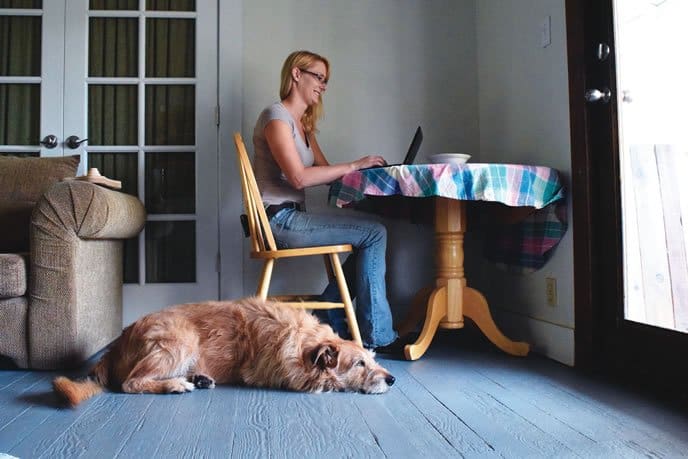
Sit. Target. Go out. Jump. Fetch. Roll over. Turn on the light. Close the door. In sharp contrast to the rigid, behavior-suppressing training methods of days gone by, we in the modern, positive reinforcement-based training world take great pride in our ability to get our dogs to do lots of stuff. Fun stuff. Creative stuff. In our zeal to teach behaviors and encourage our dogs to offer behaviors, we sometimes overlook the importance of being able to ask our dogs to turn it off, settle down, and relax. That can be a serious oversight.
In the Basic Good Manners classes at my training facility (Peaceable Paws in Fairplay, Maryland), we always teach a “settle” exercise. This is just partly to prevent the dog owners from creating a dog who is so happy about receiving treats for doing stuff that she learns to offer demand behaviors in order to keep the reinforcement coming.
These dogs are easy to spot. When there’s a pause in the action – say, when the instructor is explaining the next exercise or giving the class a short break – you may hear a low “Woof” from one corner of the room. While some dogs are happily relaxing on their mats, lapping from their water bowls, or sniffing the ground, this dog is sitting bright-eyed in front of and making meaningful eye contact with her human.
“Woof!” she says, as the bark gets sharper and more insistent. “Let’s keep doing stuff! I’d like more treats, please!” she seems to say. And the owner, in an attempt to avoid disrupting the class, feeds treats to keep the dog quiet.
“Well, now,” the dog thinks to herself. “Barking is yet one more behavior that gets reinforced. I believe I’ll bark again!”
This is a great place to insert a reminder about one of the basic tenets of positive reinforcement training: Feed/reinforce the behavior you want. Reinforcement increases – or at least maintains – a behavior. If you feed barking, you get barking!
Ideally, you will teach your dog the “Settle” behavior before she learns to bark for reinforcement, but the exercise can also be used to modify the behavior of a demand barker. (In the meantime, you can preempt a demand barker by giving her something to keep her busy – that food-stuffed Kong toy – before she starts demand barking.)
Teaching Your Dog to Settle
In our classes, “Settle” means to relax lying down on one hip for an extended period of time (several minutes) on a mat or rug. This exercise teaches your dog to lie quietly at your side while you are otherwise engaged.
1. Sit in a chair with your dog next to you, and invite her to lie down. Lure her down, if necessary.
2. When she is down, click or say “Yes!” and treat, then quickly click and treat again, before she has time to get up. (If you can get her to rock onto one hip by moving the treat to the side and toward her ribs, even better. She should be relaxed, not poised to leap into action!)
3. Continue to click (or “Yes!”) and treat several times while she is down, then say “Release!” and invite her up.
4. Gradually increase the time between clicks, so she is staying down on her own, waiting for the next click. When she will stay down with only a few clicks for 20 seconds or more, add the cue “Settle” before asking her to “Down.” (Eventually you will drop the “Down” cue and just cue her to “Settle.”)
5. Continue to decrease your rate of reinforcement (number of clicks and treats) until she can lie quietly at your feet for an extended period with very little reinforcement. (Tip: This is a great one to practice while watching television; you’re just hanging out anyway!)
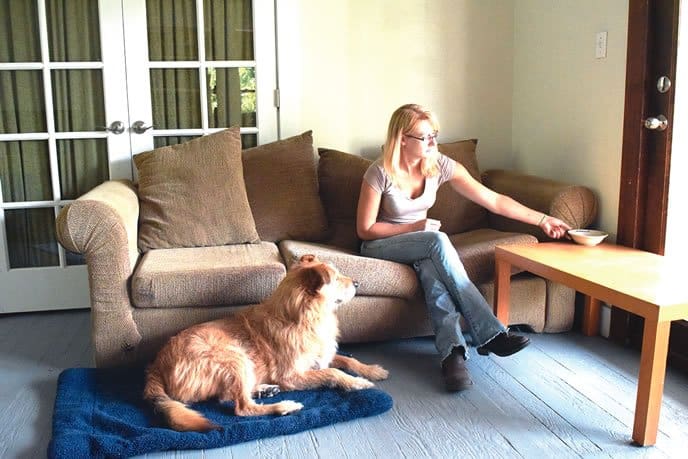
What should you do if she doesn’t just “settle”?
Challenge: Your dog won’t lie still for very long.
Solution: Practice for shorter bits of “settle.” Try to release her before she “releases” herself, and very gradually increase the length of time you ask her to remain settled.
Challenge: Your dog won’t lie still at all.
Solution: She probably has too much energy! At least at first, try practicing this exercise when she’s had a good, hard exercise session and you know she’s tired. Set her (and yourself!) up to succeed.
Challenge: Your dog will settle nicely when it’s just you there, but not if anyone else is present.
Solution: First, use the solution above (a good, hard exercise session) and then practice. Start with just one other person present, and ask your helper to just sit quietly in one place at first, ignoring your dog. Very gradually add small bits of activity, conversation, and/or different or additional humans.
Install an “Off Switch” on Your Dog
More than 20 years ago, Keli, an uber-high-energy and tennis-ball crazed Australian Kelpie, taught me the value of installing an “off switch.” I continue to find it a useful behavior to this day. Keli was one of those persistent pooches who, if you tried to end a play session, would drop the ball at your feet several times, then in your lap repeatedly, finally barking at you in frustration, no doubt thinking, “Omigosh these silly humans can be soooooo slow to catch on sometimes! What does a dog have to do to teach them to toss a ball??!!” She would fetch a ball until she literally keeled over from exhaustion (that actually happened twice in her lifetime, once requiring an emergency trip to the vet hospital!).
An effective way to turn off activity in an action-loving dog is to teach an “all done” cue. This one doesn’t specifically tell the dog what to do – it just signals to her that the activity is over. Use any cue that makes sense to you, such as “All done!”, “That’s all!”, or the often-used herding phrase, “That’ll do (pig)” from the movie “Babe.”
The sooner you “install” an off-switch in your high-energy, activity-persistent dog, the better. The longer the reinforcement history for persistence, the more persistent she’ll be.
1. Start teaching this behavior by engaging in your dog’s favorite activity – say, fetching a ball.
2. After a reasonable period of fetch time, say “All done!” and put the ball away, out of sight, perhaps in a nearby cupboard.
3. Give your dog a reasonable alternative that she can do by herself, such as emptying a stuffed Kong.
4. Go sit down and occupy yourself with something, such as reading a book, watching TV, or web-surfing.
5. Ignore any attempts on your dog’s behalf to re-engage you, such as going to the cupboard and barking, or bringing you a different toy. Don’t even repeat your off-switch cue, just ignore her.
6. Warn all other nearby humans to similarly ignore her attempts to engage them in activity when she’s been given the “All done” cue.
7. Be prepared to quietly (so as not to get her aroused again) praise her when she finally lies down and starts to chew on the stuffed Kong.
8. Use your off-switch cue every time you end a play session with her favorite activity, and don’t give in if she persists. The more consistent you are, the sooner you will see her resign herself to the fact that the fun really is over when you say it is.
Use a Dog Bed to Get Your Dog to Settle Down
A third useful exercise is Go To Your Spot, which teaches your dog to go to a specific place to lie down and relax. This can be a fixed location in your home (in front of the fireplace, by the toy box, etc.), but I find it more valuable to use a portable carpet square, mat, or dog bed of some sort. This gives you the flexibility to send your dog to her spot wherever you are; you just have to take her mat along with you. This behavior is very useful for a dog who tends to “bug” you (or your guests) for attention.
1. Take your dog to a bed, mat, carpet square, or throw rug you have obtained for this purpose, say “place,” “go to bed” (or whatever word or phrase you plan to use). You can lure her to the bed with a treat, or place a treat on the bed and encourage her to go to it and eat it. Click or say “Yes!” when she does it, then ask her to “Down,” and click and treat for that.
2. Do this a number of times until you think your dog is beginning to associate the word or phrase with lying down on the mat.
3. Then you can start cueing the behavior without the lure. Click (or say “Yes!”) and give her a reward when she complies. You can also request a “Wait” so she doesn’t pop right back off the mat.
4. When the dog is doing this part well, begin moving farther away from the mat before giving your “Place” cue.
5. Ultimately, if you wish, you can ask your dog to go to her place from anywhere in the house. You can name several different places and teach her to go to each on your request. You can also take the mat with you when you go out and use it in public or at friend’s houses (this is why a small, portable throw rug or mat is ideal).
One alternative to the approach described above is to “shape” the behavior. This is done by marking (click or “Yes!”) and rewarding any behavior remotely related to the mat, gradually raising the criteria (what she needs to do to get a click and treat) until she reliably goes to the mat and lies down on it. Add the cue when she reliably moves to the mat, and then go to Step 4 above.
Challenge: Your dog lies near or only partially on the mat in an effort to be nearer to you or your guests (or whatever he’d rather be doing).
Solution: Be clear about how much of your dog has to be on the mat for it to “count” (your choice!) and reinforce your dog only if he meets that standard.
Now Do It!
If you teach your dog all three of these cues, you’ll find that they work beautifully in concert with each other. Tell your dog the action is over for now with her “All Done” cue, put her ball away, and then you can either leave her to her own devices or ask her to settle as you give her a stuffed Kong. Cue your dog to go to her mat, and when she gets there, the “Settle” cue will remind her to relax and hang out while the family eats dinner in peace.
And remember – all three cues will work better for you and your dog if you heed our constant (nagging) reminders to provide your dog with adequate exercise – a tired dog is a well-behaved dog, and makes for a happy owner!
Pat Miller, CBCC-KA, CPDT-KA, is WDJ’s Training Editor. She lives in Fairplay, Maryland, site of her Peaceable Paws training center, where she offers dog-training classes and courses for trainers. Pat is also the author of many books on positive training, including How to Foster Dogs; From Homeless to Homeward Bound.
Give Your Dog a Smooth Recovery
Dogs are lousy patients. It’s as simple as that. True, they don’t constantly call for a glass of water or a plump of their pillow, but that’s precisely the problem: Often unable to communicate distress, and possessing a stoicism that masks their true level of discomfort, dogs can mislead their owners into thinking that all’s well after a surgical procedure, when in fact it’s anything but.
Dogs are such over-compensators, in fact, that they often will display Olympic aspirations, trying to chase squirrels, barrel through doors, and leap out of cars without so much as a care that they’ve just had a complex orthopedic procedure with more stitches than Betsy Ross’s flag.
It’s up to you, then, to be the spoilsport, and to keep your dog calm, quiet, and otherwise compliant during the recovery period, which can last weeks and even months, depending on the procedure.
With all that in mind, here are some tips for managing your dog’s post-surgery recovery—along with warnings about what to look for when things just aren’t going right.
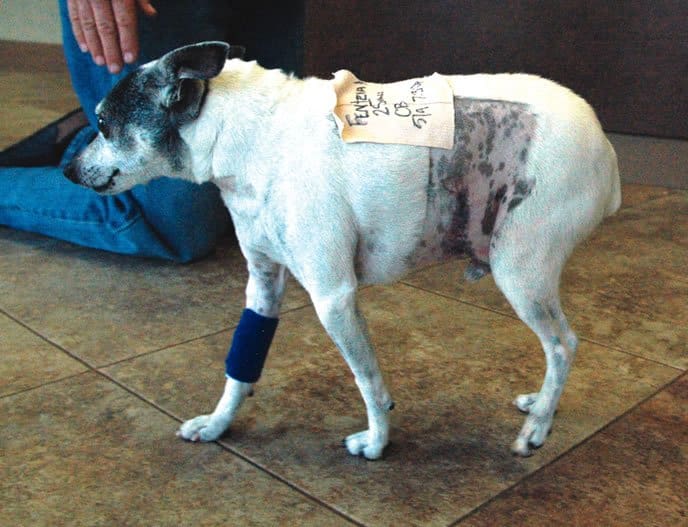
Before You Leave the Vet Post-Surgery
Of course you will be eager to take your dog home, especially if his hospitalization was longer than a day or two. But make sure you understand every post-surgical care instruction given to you by the veterinarian or her staff before you head home. Take a good look at the surgical incision if it’s uncovered, so you know what it looks like before you are left alone with it (so to speak). Get clear on how long any dressings, pain patches, or bandages are supposed to be left in place.
Importantly, look carefully at the medicines that are being sent home with you—actually read the labels and open the bottles or tubes or boxes, so you are certain you understand exactly how much of which medication he is supposed to receive, how many times a day, and exactly how you are supposed to administer each one. If a medicine is given in a form you’ve never had to administer to your dog before (ear drops, eye ointments, pills, oral liquids), ask if someone could show you how to give your dog the first dose. Make sure you know whether the medication is supposed to be kept refrigerated or not.
Finally, it’s time to leave—but don’t head out to the car and just open the door and allow your dog to leap in like always! Anticipate the possibility that he will be so eager to leave the clinic and return to his familiar places that he may forget he’s wearing a cone, cast, brace, or bandages. Keep your leash taut and block his usual access to the car so that you (and perhaps a clinic staff member or family member, if he’s a big dog) can lift him gently into the car. If he’s too big to maneuver, use a ramp to help him climb slowly into the car, and be sure to have someone on each side of the ramp to steady him.
Ideally, someone could ride in the car with your dog in the back seat, or he could be safely crated in an especially well-padded crate for the slow, careful drive home.
Again, when he gets home, he may get very excited and eager to leap out of the car and back into his old life. Anticipate his enthusiasm and control his movements carefully.
The Post-Canine Surgery Overview
A dog views life pretty much at knee level. (Or, in some cases, ankle level.) Such a ground-hugging perspective leaves him that much more likely to get dirty. “Think about if you had knee surgery, and then you laid down on the ground and dragged that incision around,” says Dr. Tomas Infernuso of Veterinary Traveling Surgical Services in Locust Valley, New York. “Tell me: Is it going to get infected?”
Your dog might make a habit of plopping himself down on a favorite spot on the lawn, or lounging on the cool floor tiles in the mudroom. But in the days and weeks after surgery, he’ll need to be lying on clean sheets and bedding. If the dog bed is covered with a thatch of hair and God-knows-what-else, either give it a good go-round in the washing machine, or cover it with a clean sheet or comforter. Be sure to change the bedding frequently.
(All this talk about staying off dirty floors doesn’t mean your dog should seek higher ground: Climbing on couches and beds can strain incisions. Keep your dog off the human furniture.)
Unless it contradicts your veterinarian’s orders, make lots of water available so your dog can rehydrate after surgery. More water intake means more peeing, so plan on lots of walks—always on leash, please, even if it is just to the backyard—as well as the occasional accident if you get can’t out in time.
Controlling Your Dog’s Activity After Surgery
Keeping your dog off floors and less-than-sanitary surfaces is just the beginning. “Dogs are athletes,” says Dr. Infernuso. “Once the inflammation settles down and they feel better, they push themselves. Dogs just don’t get it. So it’s up to you to control their activity.”
While many owners feel sorry for their dogs, confinement is an absolute requirement after surgery. When not intensely supervised, your dog should be in his crate, and all walks need to be on leash—even strolls around the house.
Dr. Infernuso says he’s even had to amputate a dog’s leg as a result of an owner being too blasé about confinement: The dog jumped through a screen door 10 days after returning home, fracturing the surgery site, which later became impossibly infected. “That was 100 percent the owner’s fault,” he says. ” Now I tell people, if you can’t control your dog, I’m not doing surgery, because it’s going to be detrimental to the dog.”
Ripping stitches is another complication that can result from letting your dog do too much, too soon. Dr. Infernuso recalls another case, this time a 100-pound Rottweiler who tore his incision so badly his bladder and intestines were peering through the sewn skin. Initially proclaiming his innocence, the owner eventually admitted to letting the dog jump out of his pickup truck on the trip home.
With dogs who are prone to hyperactive or over-exuberant behavior, Dr. Infernuso will sometimes prescribe Acepromazine, a commonly used sedative. In very severe cases, he will keep the dog on the drug for as long as a month or two, until the healing process is well underway. While keeping a dog sedated that long is not ideal, it beats the alternative if an owner is unable or unwilling to confine a dog properly.
Speaking of confinement, make sure your dog has a quiet, warm spot that affords her lots of rest and few distractions for the first few days of her recovery. Make sure she can’t be bothered by other animals in the household, as well as any small children who can unintentionally push your dog past her limits, especially in the haze of post-surgical pain.
The Dreaded Dog Cone
A dog’s propensity for licking her wounds is another way that bacteria get a foothold; even a surgical site on the head or neck area isn’t safe, because of the potential for constant scratching. As a result, most convalescing dogs are required to wear an Elizabethan collar (also known as a “cone”) or some alternative product. While it does prevent a dog from worrying her wound, this lampshade-like barrier, which attaches to the collar, can obstruct her vision and makes navigating in small places very difficult. For whatever reason, many veterinarians sell Elizabethan collars that are made of very stiff, hard, and opaque plastic. Be advised that many pet supply stores sell similar products that are made of lighter, translucent plastic, which helps the dog see and carry the cone around.
Some owners eventually remove the cone before they should because they feel badly for the dog, who sometimes looks profoundly uncomfortable – or, at the very least, very annoyed. Instead, consider one of the soft fabric cones, which do much the same job without so much rigidity. Dr. Infernuso dissuades people from using inflatable cones, as he finds that while wearing them, “dogs can still reach incisions and open them up.”
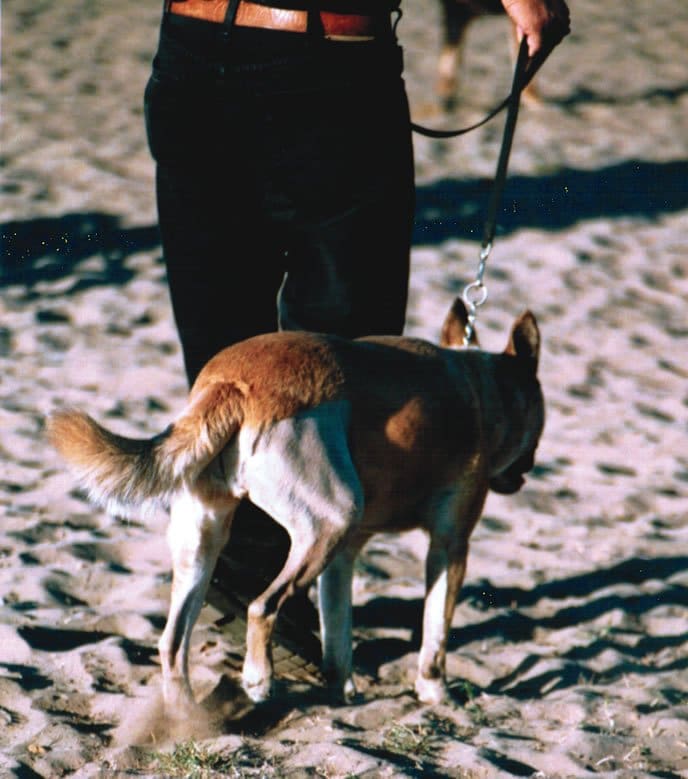
Nursing Your Dog’s Wounds
Knowing how a wound heals—and what it looks like during the process—is tremendously important: Carefully monitoring the incision in the days and weeks after surgery can help you flag early signs of trouble.
Dr. Infernuso instructs his owners to clean the wound area twice a day with an antiseptic solution such as Betadyne or antibiotic ointment, wearing latex gloves to be sure they do not contaminate the incision.
“I don’t know how effective it is in decreasing the bacterial load, but I want people to pay attention to the wound,” he says. Requiring a twice-daily check of the wound not only makes owners feel useful, but it builds in time every day for them to notice any problematic changes.
Immediately after surgery, expect that the incision site will not look happy. “Bruising, swelling, and edema are completely normal,” Dr. Infernuso says, adding that the area might be bluish or reddish in color. In this initial inflammatory stage, which lasts about three to five days, you can expect to see a puffy and bruised area, as the body reacts to the trauma of surgery. The skin may appear to be puckered around the incision; this is normal.
If there is any drainage, it should be clear, but owners should not expect large amounts of it. “You should be concerned if the wound starts looking really hot, really painful to the touch,” Dr. Infernuso says. “Pre-infection, you’ll see serous fluids, followed by organized liquid, usually pus.” Any type of foul-smelling discharge is also not normal. At the first sight of these warning signs, contact your veterinarian, who will likely want a recheck.
After the inflammatory stage, your dog’s body will go into the healing phase. “This is the beginning of collagen formation, and of repair,” Dr. Infernuso explains. If you still see inflammation, redness, and soreness at this juncture, it’s another reason to call your vet.
Manage Your Dog’s Pain
Pain management is certainly important from a compassionate point of view: After all, no one wants to see a dog suffer. But keeping your dog’s pain under control can also have an impact on his recovery.
In the aftermath of surgery, the body can experience a “sympathetic surge,” in which the sympathetic nervous system—which is responsible for “fight or flight” mode—goes into overdrive. This stress response triggers metabolic and hormonal changes that can depress the immune system and impede the healing process. Controlling pain can curb this natural response, leaving the body free to devote its energy to the repair of damaged tissue.
Creating a chart of what medications to give when can be helpful in managing your dog’s prescriptions, which may include antibiotics as well as painkillers. Don’t add any supplements to your dog’s food during the convalescing period without consulting with your vet. If you’ve got one of those dogs who spits like a camel at any attempt to “pill” him, try hiding the capsule in a morsel of delicious food, like a chunk of steak, or Pill Pockets, which are soft treats with an indented center for hiding the pill.
Entertain Your Dog After Surgery
One of the ironic downsides of lessening your dog’s post-operative pain is that it will be more difficult to keep him quiet while he’s recuperating. In the pre-digital age, human convalescents received gifts of word-search books and paperback novels to help them while away the hours; today, bed-ridden hospital patients can be found tapping away at their smart phones and iPads. Dogs get bored, too, but they don’t have Candy Crush Saga as an option. Instead, you need to provide the mental stimulation they need to keep from going stir-crazy.
That old standby—a Kong toy stuffed with treats stirred into peanut butter or yogurt, then frozen—can provide a couple of hours of distraction. Hidden food puzzles, such as the Zoo Active toys developed by Nina Ottosson, and other interactive toys are perfect for keeping your dog’s brain engaged during this time. (See “Puzzle Fun,” WDJ June 2008, for a review of interactive toys.)
Teaching your dog simple tricks that don’t require a lot of physical exertion are a great way to keep his mind occupied and his body quiet: Rolling a ball, barking on command, picking up objects, targeting your hand—you can use shaping and clicker training to easily put these on cue. Scent-discrimination games are another low-impact activity that burn a tremendous amount of mental energy: Choosing between two objects, one of which has your scent, is a game that can be played even if your dog needs to be restricted to her crate.
The variety of games you can play is seemingly endless: A little Googling or a search on Youtube will give you lots of creative ideas.
Rehab Therapy for Dogs
As in human medicine, a variety of therapies are available to help speed your dog’s healing process, including cold-laser therapy, acupressure, and acupuncture.
Getting patients up and moving—always in a controlled setting, of course – can also be very beneficial. “Orthopedic surgeons will not do surgery on humans without physical therapy afterward,” Dr. Infernuso says. “Today, with all these rehab centers for dogs, I advocate for therapy right away.” Water therapy can be a great low-impact option, once concern about keeping your dog’s incision dry is no longer an issue.
For many conditions, physical therapy can enhance recovery, allowing the dog’s muscles to regain their strength in an organized fashion.
And that, in the end, is the whole key to your dog’s success after surgery: Slow, steady progress, in an environment that stresses rest and controlled activity, is the recipe for returning him to his bouncy, bright-eyed self.
Denise Flaim of Revodana Ridgebacks in Long Island, New York, shares her home with three Ridgebacks, 11-year-old triplets, and a very patient husband.
Download the Full September 2015 Issue PDF
Subscribe to Whole Dog Journal
With your Whole Dog Journal order you’ll get:
- Immediate access to this article and 20+ years of archives.
- Recommendations for the best dog food for your dog.
- Dry food, homemade diets and recipes, dehydrated and raw options, canned food and more.
- Brands, formulations and ingredients all searchable in an easy-to-use, searchable database.
Plus, you’ll receive training and care guidance to keep your dog healthy and happy. You’ll feed with less stress…train with greater success…and know you are giving your dog the care he deserves.
Subscribe now and save 72%! Its like getting 8 issues free!
Already Subscribed?
Click Here to Sign In | Forgot your password? | Activate Web Access
Time to Get Seriously Social

This summer is FLYING by. There is so much to do. But there’s one task right under my nose that hasn’t been getting done, that HAS to get rolling: socializing “Mommy,” the Dachshund/Chihuahua-mix I’ve been fostering for . . . gosh, I don’t even know how long.
Let’s see, I went to the shelter looking for a puppy to photograph for an article in the June issue, and we put that together in April . . . When I saw this cute little mommy dog trying valiantly to protect and raise her tiny, single, three-week-old puppy in the shelter, I immediately asked if I could foster them both. I took them home that day.
I didn’t do that much with the mother dog while she was busy raising her baby; they needed to be together. But the puppy was adopted a month ago . . . and while I do take the mother everywhere I take my two dogs, and have her practice the minor daily behaviors I ask them for – come, sit, down, “food bowl wait,” go potty on cue (for pee breaks during the day), hop in the car, get out of the car – I haven’t been focusing solely on her social skills, and she needs remedial work. Is it possible this dog has been here for almost four months, and still hasn’t really met that many people?
I hate to admit it, but yes. The poor little dog doesn’t even have a proper name, yet! It should be something that sort of rhymes with Mommy, though, because she responds really well to that; since she’s been spayed, though, and not going to have to be a mommy anymore, I really want her to have a nice identity of her own.
And that’s the challenge, for two reasons: First, because my local shelter, like so many, is full of Chihuahua-mixes in every shape and color. This “type” of dog is so common that it’s hard for people to be able to pick a really nice one out of a crowd. But this is a very sweet, smart, funny little dog. She’s completely nonreactive to my cats and chickens, and is happy to ignore any other dog as long as they ignore her. If, on a walk, we encounter a yapping, hysterical little dog, or a barky, giant dog on the other side of a fence we are trying to walk past, she sidles calmly to my far side, looks a little blinky, but doesn’t engage with the dog and certainly doesn’t get hysterical herself. She bonds with whoever takes care of her very quickly and tightly, and just sort of goes with the flow.
That said, the second challenge to getting her adopted is the way she “shows” to new people; she’s afraid of new faces and voices. She cowers and tries to hide, and if she’s really trapped and someone comes on very strong, she will growl a little. I’m having every member of my family and every visitor to my office give her treats when they come, and she’s improved a LOT – but I don’t have nearly as many friends coming by as needed to super-socialize her. And I haven’t made an effort to take her out to parks and public spaces where I could work on some dedicated counter-conditioning and desensitization. But that’s what I need to do to get her comfortable enough to be able to find a new home.
So, be it resolved: She’s the project of the month. But, would you help me out with a name?

Who Doesn’t Scoop Poop?
It’s very difficult for those of us who always scoop our dogs’ poop to understand those who don’t. I honestly have never heard anyone defend their habit of looking the other way (and then walking the other way!) when their dog defecates somewhere he or she shouldn’t – such as on a public sidewalk, on someone else’s lawn, or outside of a hotel – and I really just can’t imagine what such a person is thinking when they do this.
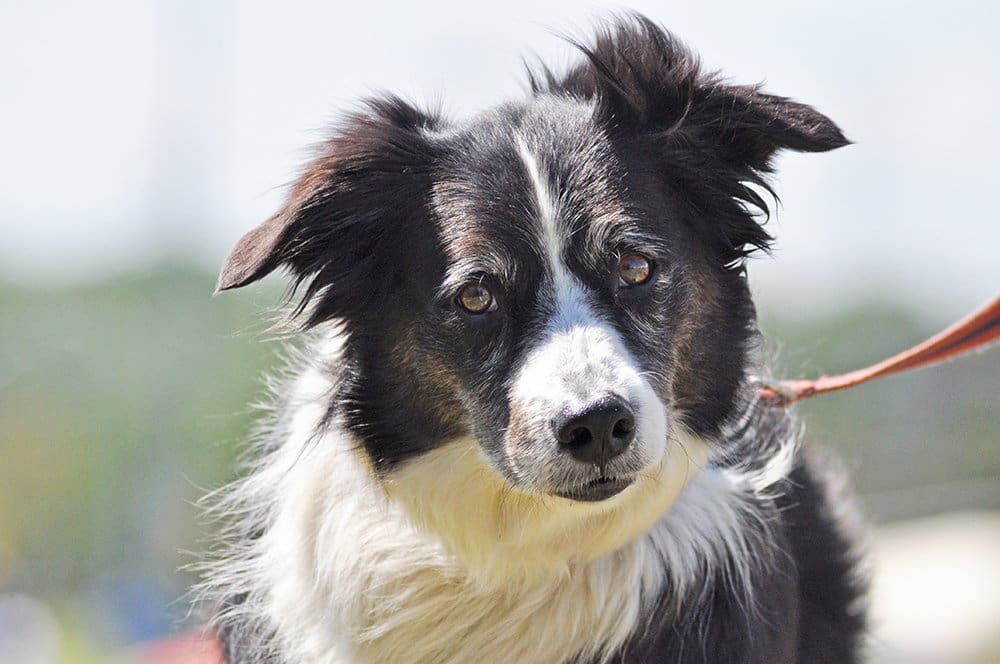
That said, anyone can be caught without a bag or scooper at some random time. I myself have been guilty of walking my dogs a short distance in my neighborhood without a bag with me after I saw them poop in my own backyard – and then being surprised that one of them still had a little more poop to offer (so to speak) on the walk.
But when I’m caught without a bag, I’ll do anything to find something to pick up the poop. My first tactic is to look for trash – a floating plastic bag, a fast-food wrapper, a soft-drink cup – that I can use. The kind of free advertising newspapers that tend to linger in driveways are good for this purpose. Lacking any of these things, I’ve dumped out coffee I was drinking and used the paper cup to scoop and carry! I’ve also left a leash on the ground near the poop, kept walking until I’ve found something to use, and gone back to where I left the leash to complete my dog-owner responsibilities.
But apparently people do walk away from their dogs’ poop without a second thought! Enough of them do so, in fact, that from time to time we see media reports of another town or neighborhood, or most recently, a large condominium complex, who has engaged the services of a company that can match the DNA in abandoned poop with its canine pooper! The latest was a report in the New York Times about a complex with about 440 condos, counting some 175 dogs among its inhabitants, that recently required all of its residents to register their dogs and submit DNA samples for enrollment in such a poop identification program.
I have to ask: WHO DOES THIS? And why?

Download the Full August 2015 Issue PDF
Subscribe to Whole Dog Journal
With your Whole Dog Journal order you’ll get:
- Immediate access to this article and 20+ years of archives.
- Recommendations for the best dog food for your dog.
- Dry food, homemade diets and recipes, dehydrated and raw options, canned food and more.
- Brands, formulations and ingredients all searchable in an easy-to-use, searchable database.
Plus, you’ll receive training and care guidance to keep your dog healthy and happy. You’ll feed with less stress…train with greater success…and know you are giving your dog the care he deserves.
Subscribe now and save 72%! Its like getting 8 issues free!
Already Subscribed?
Click Here to Sign In | Forgot your password? | Activate Web Access
Car Safety
One shouldn’t watch the latest videos from the Center for Pet Safety (CPS) on a full stomach. Even though NO ACTUAL DOGS ARE HARMED in the videos, watching a few of them may make you feel ill.

The videos are the product of the CPS’s latest round of testing safety restraint systems for dogs who are passengers in our cars. The CPS, you may remember, is the nonprofit organization prominently featured in WDJ’s January 2015 article, “Restraining Order,” which discussed CPS’s testing of car safety restraints for dogs. (Also discussed at length: the fact that only two harnesses on the market passed the crash-tests. The article, available free to our subscribers, appears here: https://www.whole-dog-journal.com/care/collars-harnesses-leashes-muzzles/whole-dog-journals-car-safety-harness-recommendation/
).
CPS has been testing crates and small-dog carriers – including “regular” carriers (about which no crash-testing or crashworthiness claims have been made) and those that are being specifically marketed with claims of providing increased safety for dogs in car crashes. Some have been sold as “crash-tested,” even though you can see from the CPS’s videos that the products clearly could not have PASSED any significant crash test.
The CPS developed a number of canine crash test dummies so as to replicate the weight and shape of dogs of several sizes. Appropriately weighted and shaped dummies test the products far more accurately and thoroughly than, say, a stuffed animal dog that tips the scales at a fraction of a real dog’s weight.
Even though you know they are dummies, not real dogs, it still makes a person queasy to watch the videos, which show the dummy dogs getting crushed by the fragments of splintering crates, thrown out of disintegrating crates, and lodged half in and half out of wrecked crates. Only one crate for large dogs survived the crash tests intact, and only a few carriers for small dogs kept the small-dog dummies safely inside the carrier and on the seat.
Check out the study and videos (if you dare) – and then let us know: Will these studies change the way you transport your dog?
CPS Crate study:
http://www.centerforpetsafety.org/test-results/crates/2015-crate-study-results/
CPS Carrier Study:
http://www.centerforpetsafety.org/test-results/carriers/2015-carrier-study-results/

Analyzing Commercial Diets
I couldn’t be more excited to introduce this new column in Whole Dog Journal. I’ve been wanting to find someone to write a regular column about home-prepared cooked and raw diets for WDJ, but no one I’ve discussed it with and proposed it to has been able to commit to the amount of work it’s going to take. Allow me to emphasize the part of that previous sentence that finally opened the door to presenting the column: the phrase no one. You see, several of the people I spoke with were willing to provide some of the work of the column. What I needed to do was to build a team of like-minded and experienced home-prepared diet formulators and raw-diet feeders who could collaborate on the creation of diet guidelines and analysis of products and recipes prepared by other formulators.
Happily, a sort of canine-diet dream team has come together to work on a series of articles that will help owners formulate healthier home-prepared diets for their dogs – or identify the commercial raw diets (fresh, frozen, or dehydrated) that are genuinely nutritionally “complete and balanced” (in contrast to the vast majority that claim to be complete and balanced, but have potentially serious nutrient overages, deficiencies, or imbalances).
All of the people who will contribute to this column are experienced with raw and home-prepared diets, but each brings different strengths to the project. In this, the inaugural installment of the column, I’d like to introduce each of the contributors, briefly describe their backgrounds, and allow them to explain their motivation and goals for this column to you. Each of them has a fascinating and deep “back story” regarding his or her experience and interest in canine nutrition, and I think you will enjoy getting to know them as much as the topics they will soon be writing about.
Then, next month, we’ll dive right in with some analysis of the most common problems they see in the commercial raw diet marketplace. This will help illustrate why most of us would be better off learning to prepare our dogs’ food ourselves, rather than outsourcing the job to commercial manufacturers.
Here is our canine diet analysis team:
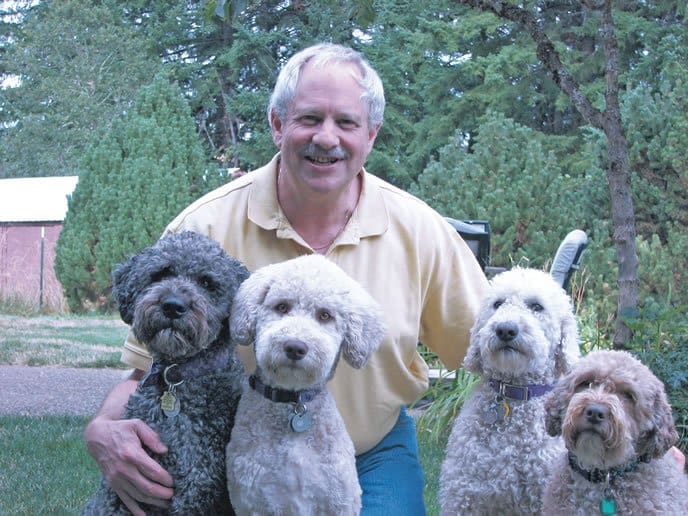
– Steve Brown
His first professional career was in the technology industry, but Brown “went to the dogs” in the late 1990s. A search for a small, low-calorie treat for his dog led to his development of a product called Charlee Bear dog treats. This entrée to the pet food industry sparked an interest in canine nutrition – and the more he learned about the field, the less satisfied Brown was with the conventional diets on the market. He developed another very successful product, a line of raw frozen canine diets, “Steve’s Real Food for Dogs,” which made its market debut in 1998 (Brown is no longer affiliated with either Charlee Bear or Steve’s Real Food for Dogs).
Brown has provided consultation services to other raw frozen pet food companies, and wrote two valuable books on canine nutrition, Unlocking the Canine Ancestral Diet and See Spot Live Longer, as well as the booklet, “See Spot Live Longer the ABC Way.” Brown lives near Eugene, Oregon.
Brown will be contributing his knowledge of commercial pet food producers, perspective as an experienced diet formulator, and his amazing database of nutrient information for every ingredient ever used in dog food.
– Steve Brown says – I’m one of the founders of the raw diet industry, and one of the more detailed-oriented formulators in the industry. I’m almost ready to retire from dog food and start my next project, which has nothing to do with dogs or food. But before I retire I have a few things to say and do.
I’m very happy with the growth of fresh, raw, and ancestral-type feeding. Twenty years ago when I started, there were maybe 10 stores in the nation that had freezers for raw pet foods. Now there are tens of thousands of stores selling raw diets and perhaps hundreds of thousands of people who make their own foods. The spectacular growth shows there is tremendous interest in raw and ancestral-type diets for dogs.
I’m quite upset at some companies and some authors of homemade recipes. I’ve seen some bad “raw” diets out there, commercial and homemade. Many people and producers have jumped on the raw bandwagon with little if any basic knowledge of nutrition. I’m particularly upset with some of the best-selling raw diet companies, and their misstatements, poor analyses, and lack of care to do things right.
It’s my goal for the first installment in the column to help educate WDJ’s readers and the overall market on how to identify properly formulated commercial raw diets. I’d also be happy for it to shake up the commercial raw diet industry and force some of the companies that have products in this category to formulate correctly or stop calling their products “complete” foods.
In future articles, we’re going to show you how to evaluate homemade dog food recipes, and then how to make your own ancestral-type homemade diets that meet American (AAFCO) and European (FEDIAF) standards. Once this is done, I can retire.
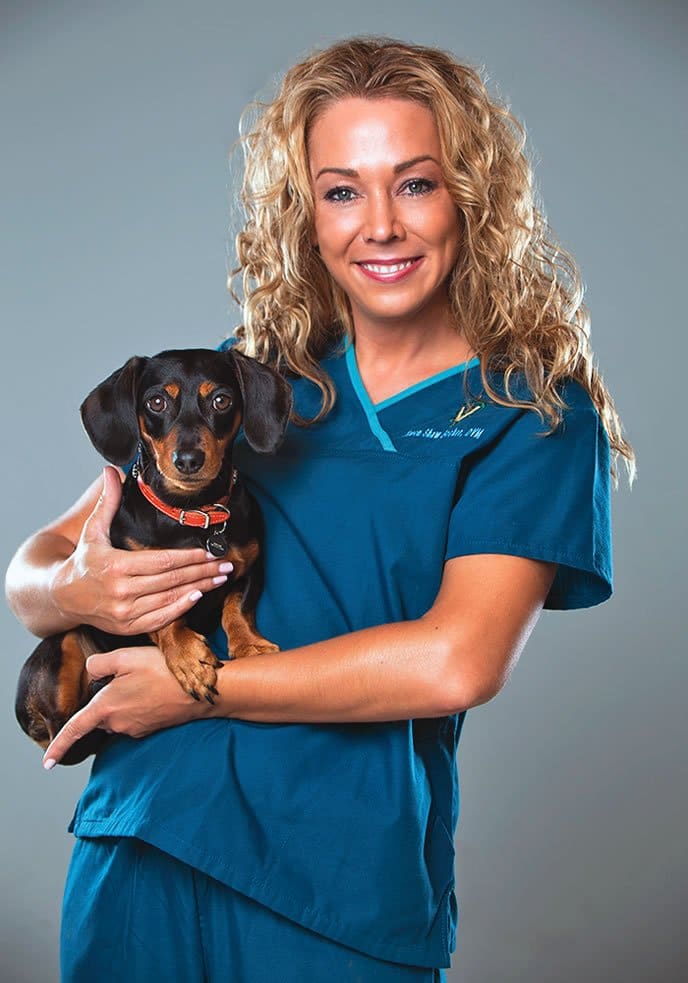
– Karen Becker
A veterinarian with a passion for promoting species-appropriate, top quality diets for every animal, Dr. Becker is the author of Dr. Becker’s Real Food for Healthy Dogs & Cats, currently in its third edition, and (full disclosure) the creator of one of WDJ’s favorite dog treats, Dr. Becker’s Bites. She incorporates a love of clinical pathology and integrative medicine in her holistic veterinary medical practice, Natural Pet Animal Hospital in Bourbonnais, Illinois (an hour south of Chicago). She attributes much of her clinic’s success to the fact that nutrition is addressed with every patient, at every exam.
Dr. Becker will contribute her long experience with feeding raw and cooked home-prepared diets to dogs, and, in fact, improving the health of her canine patients with properly formulated diets. We will count on her to provide the veterinary perspective on the food/health connection.
– Dr. Becker says – I’ve been a homemade dog food girl since vet school, when the free dry food from a major prescription pet food company sickened my dog; I believe it was caused by ethoxyquin toxicosis. I turned to an intense detoxification protocol and a species-appropriate raw food diet, which I believe saved her life. This experience not only changed my perspective as young holistic veterinarian, but also shaped the way I viewed the formulation of fresh food diets. At that time, there were no raw food diets on the market and I knew most homemade recipes were unbalanced, including my own.
My desire to create nutritionally balanced, species-appropriate meals for my pack and my patients fed my passion for furthering my understanding of nutrient requirements for optimal health, especially as a steady stream of sick animals visited my practice. As commercially available raw food diets began entering the market I assumed these convenient alternatives to entirely processed pet foods would finally create a generation of healthier pets. But that didn’t happen to the extent I was anticipating. In evaluating many of these diets I found there were significant formulation flaws.
I continue to seek out diets and recipes that provide optimal nutrition for dogs and cats. I believe in educating and empowering animal guardians to be able to make wise food choices. This is the best approach for owners who want take control of their pets’ health and well being, and avoid making nutritional mistakes that could ultimately harm their pets.
I am partnering with WDJ and experts in the field of raw food nutrition to provide educational information that fosters positive changes in the pet food industry, positive discussions among holistic veterinarians and nutritionists, and, most importantly, improves the way you choose to nourish your dog.
– Mary Straus
A retired software engineer who began putting her prodigious research and analysis skills to work on canine diets in the late 1990s, Straus calls her deep interest in home-prepared diets an “avocation.” I don’t know anyone else whose hobby has resulted in their contribution of so many searching and in-depth articles (to this publication and others) on canine nutrition. Her work has sparked improvement in many canine diets, both home-prepared and commercial. She lives in the San Francisco Bay area, and shares her discoveries about canine health and optimum nutrition on her website, DogAware.com.
Straus can out-calculate engineers twice her size and has the research tenacity of a terrier in a rat-infested hay barn. She would rather wrestle with a spreadsheet or fact-check a scientific paper on the AAFCO nutrient profiles than write an article about all the anomalies and errors she found – but she’s happy to explain them to other canine-nutrition obsessives. With Straus helping to “run the numbers” on the diets the team analyzes and creates, we can be assured of infallible data.
– Mary Straus says – My interest in raw diets began when I visited Wolf Park in Indiana, and watched them feeding whole deer carcasses to the wolves. I spent the next year researching raw diets before starting my own dogs on a homemade raw diet in 1998.
My interest in nutrition continued to grow as I researched everything I could find over the next 17 years. I don’t recall when Steve Brown and I met, but at some point, he became my mentor and friend, and his book, Unlocking the Canine Ancestral Diet, is one of those I reach for most often when I have a question about homemade diets. I believe that Steve understands more about basic canine nutrition than anyone else, including most veterinary nutritionists, and I have learned a tremendous amount from him. I’m excited that he will be sharing some of his knowledge with us here.
One of the things I learned from Steve is that the amount of fat shown on the guaranteed analysis label of all dog and cat food products may be far less than the actual amount of fat in the food. This is legal, since only the minimum amount of fat is required on the label. The actual amount of fat can be estimated by a complicated formula that relies on the company’s reported number of calories in the food – but is only as reliable as the company’s reported value for calories.
I was shocked to learn that at least one major commercial raw food company deliberately understates the amount of fat in their foods, refusing to respond to multiple requests to provide the actual amount of fat in their food (they’re willing to provide any other nutritional information except that). Note that this problem affects not only raw foods; when this formula is applied to other commercial foods, particularly canned foods (which tend to be higher in fat than dry foods), I found that many must have considerably more fat than the minimum amount on the label in order to account for the calories reported by the manufacturer for that food.
Higher-than-expected fat levels can be problematic. For example, dogs with pancreatitis may be seriously or even fatally harmed by high-fat foods. In other cases, too much fat may cause digestive upset or unwanted weight gain. When portions are restricted enough to prevent weight gain, the nutrient value of the diet may fall below the dog’s requirements. Since it may take years for nutritional deficiencies to cause signs severe enough to recognize, it is impossible to tell whether a diet is complete and balanced just by examining a dog or even by doing blood tests.
As I began analyzing homemade diets myself and comparing them to National Research Council (NRC) and Association of American Feed Care Officials (AAFCO) guidelines, I was surprised by some of the deficiencies I found. Steve helped me to realize that not all the information presented in the USDA National Nutrient Database is always reliable – which is crazy, because virtually everyone (veterinary nutritionists included) who builds complete diets for dogs relies on the information in this database to calculate the nutrient content of their recipes.
For example, in some cases the values for certain nutrients in some foods are missing. This is indicated in the database with a dash – meaning, there is no value for that nutrient in that ingredient available. If you don’t provide a value for that nutrient, it will be calculated as if the ingredient contained zero amount of that nutrient, which may or, more likely, may not be the case.
For example, more than 40 percent of the poultry products in the current USDA database do not measure choline, so if I happen to choose one of those ingredients when analyzing a diet, the diet may appear to be low in choline when in fact the amount of choline may be adequate. A similar percentage of poultry products do not measure vitamin D.
In other cases, by comparing similar items, it becomes obvious that certain nutrient values are inaccurate, due to either testing or data entry errors (I’ve also learned from Steve that lab testing can be notoriously inaccurate). While less common than missing data, these inaccuracies can also affect the ability to determine whether a homemade diet meets guidelines or not.
Steve has created a corrected version of the USDA database, for which he has calculated and inserted values for missing nutrient data and corrected values that were so obviously out of the average range that they that were likely errors. To the best of my knowledge, he is the only one to have done so. Other nutrition analyzers, including those used by veterinary nutritionists, use uncorrected data that may skew results considerably.
As I learned what foods provided certain nutrients, I’d look at ingredient lists for commercial raw, freeze-dried, and dehydrated diets that the manufacturers claimed met AAFCO guidelines, and realized that there was little likelihood that certain nutrients could possibly be provided in adequate amounts. In one case, I called a company to ask about their iodine content, and was told that they had never tested for iodine in their diets!
In other cases, I would compare a nutritional analysis of the food to AAFCO guidelines and realize that there were deficiencies, despite the AAFCO “complete and balanced” statement on the label. In one case where a company’s products definitely did not meet AAFCO guidelines, they chose to do a six-month feeding trial, which is absurdly easy to pass, to justify their claims of nutritional completeness. While this meets AAFCO’s requirements regarding label claims for a “complete and balanced diet,” it doesn’t change the fact that a number of nutrients in this company’s products do not in fact meet current AAFCO guidelines for nutrient levels.
There are also a number of commercial raw food companies that make claims on their websites and in their product literature that their diets are “complete and balanced” without providing an AAFCO “complete and balanced” statement on the product label, which is a violation of labeling laws.
A quick perusal of the ingredient lists indicates that in virtually all of these cases, the diets would not in fact meet AAFCO guidelines. Over time, I’ve noticed certain companies begin to add supplements to their foods, sometimes quietly and without any announcement, and sometimes by introducing new products that now carried an AAFCO statement but which differ substantially from their prior products that they had claimed to be complete. It was clear that they had never done a complete nutritional analysis, and when they did, they likely discovered that their foods did not, in fact, meet the guidelines for a complete and balanced diet.
Remember that commercial diets must meet all of a dog’s nutritional requirements because each may be the only food the dog ever receives.
Next month: How to separate well-formulated, truly “complete and balanced” commercial raw-food diets from the nutritionally incomplete and imbalanced products flooding the market.


